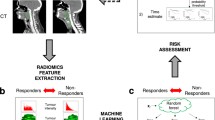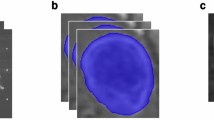Abstract
In this study, 325 subjects were extracted from the HECKTOR-Challenge. 224 subjects were considered in the training procedure, and 101 subjects were employed to validate our models. Positron emission tomography (PET) images were registered to computed tomography (CT) images, enhanced, and cropped. First, 10 fusion techniques were utilized to combine PET and CT information. We also utilized 3D-UNETR (UNET with Transformers) and 3D-UNET to automatically segment head and neck squamous cell carcinoma (HNSCC) tumors and then extracted 215 radiomics features from each region of interest via our Standardized Environment for Radiomics Analysis (SERA) radiomics package. Subsequently, we employed multiple hybrid machine learning systems) HMLS), including 13 dimensionality reduction algorithms and 15 feature selection algorithms linked with 8 survival prediction algorithms, optimized by 5-fold cross-validation, applied to PET only, CT only and 10 fused datasets. We also employed Ensemble Voting for the prediction task. Test dice scores and test c-indices were reported to compare models. For segmentation, the highest dice score of 0.680 was achieved by the Laplacian-pyramid fusion technique linked with 3D-UNET. The highest c-index of 0.680 was obtained via the Ensemble Voting technique for survival prediction. We demonstrated that employing fusion techniques followed by appropriate automatic segmentation technique results in a good performance. Moreover, utilizing the Ensemble Voting technique enabled us to achieve the highest performance.
Access this chapter
Tax calculation will be finalised at checkout
Purchases are for personal use only
Similar content being viewed by others
References
Wu, Z.H., Zhong, Y., et al.: miRNA biomarkers for predicting overall survival outcomes for head and neck squamous cell carcinoma. Genomics 113(1), 135–141 (2021)
Butowski, N.A.: Epidemiology and diagnosis of brain tumors. CONTINUUM Lifelong Learn. Neurol. 21, 301–313 (2015)
Kumari, N., Saxena, S.: Review of brain tumor segmentation and classification. In: 2018 International Conference on Current Trends towards Converging Technologies (ICCTCT), pp. 1–6. IEEE (2018)
Rahmim, A., Zaidi, H.: PET versus SPECT: strengths, limitations and challenges. Nucl. Med. Commun. 29, 193–207 (2008)
Fitzgerald, C.W., Valero, C., et al.: Positron emission tomography–computed tomography imaging, genomic profile, and survival in patients with head and neck cancer receiving immunotherapy. JAMA Otolaryngol. Head Neck Surg. 147, 1119 (2021)
Martens, R.M., Koopman, T., et al.: Multiparametric functional MRI and 18 F-FDG-PET for survival prediction in patients with head and neck squamous cell carcinoma treated with (chemo) radiation. Eur. Radiol. 31(2), 616–628 (2021)
Marur, S., Forastiere, A.A.: Head and neck squamous cell carcinoma: update on epidemiology, diagnosis, and treatment. Mayo Clin. Proc. 91(3), 386–396 (2016)
Salmanpour, M., Shamsaei, M., et al.: Optimized machine learning methods for prediction of cognitive outcome in Parkinson’s disease. Comput. Biol. Med. 111, 1–8 (2019)
Salmanpour, M., Shamsaei, M., et al.: Machine learning methods for optimal prediction of motor outcome in Parkinson’s disease. Physica Medica 69, 233–240 (2020)
Salmanpour, M., Shamsaei, M., Rahmim, A.: Feature selection and machine learning methods for optimal identification and prediction of subtypes in Parkinson’s disease. Comput. Methods Prog. Biomed. 206, 1–12 (2021)
Andrearczyk, V., et al.: Overview of the HECKTOR challenge at MICCAI 2021: automatic head and neck tumor segmentation and outcome prediction in PET/CT images. In: Andrearczyk, V., Oreiller, V., Hatt, M., Depeursinge, A. (eds.) HECKTOR 2021. LNCS, vol. 13209, pp. 1–37. Springer, Cham (2022)
Valentin, O., et al.: Head and neck tumor segmentation in PET/CT: the HECKTOR challenge. In: Medical Image Analysis (2021) (under revision)
Masoud, R.S., Abedi-Firouzjah, R., Ghorvei, M., Sarnameh, S.: Screening of COVID-19 based on the extracted radiomics features from chest CT images. J. X-ray Sci. Technol. 29, 1–5 (2021)
Rezaeijo, S.M., Ghorvei, M., Alaei, M.: A machine learning method based on lesion segmentation for quantitative analysis of CT radiomics to detect covid-19. In: 2020 6th Iranian Conference on Signal Processing and Intelligent Systems (ICSPIS), pp. 1–5. IEEE (2020)
Ashrafinia, S.: Quantitative Nuclear Medicine Imaging using Advanced Image Reconstruction and Radiomics. Ph.D. Dissertation, Johns Hopkins University (2019)
Acknowledgement
This study was supported by the Natural Sciences and Engineering Research Council of Canada (NSERC) Discovery Grant RGPIN-2019-06467.
Author information
Authors and Affiliations
Corresponding author
Editor information
Editors and Affiliations
Ethics declarations
Conflict of Interest
The authors have no relevant conflicts of interest to disclose.
Rights and permissions
Copyright information
© 2022 Springer Nature Switzerland AG
About this paper
Cite this paper
Salmanpour, M.R., Hajianfar, G., Rezaeijo, S.M., Ghaemi, M., Rahmim, A. (2022). Advanced Automatic Segmentation of Tumors and Survival Prediction in Head and Neck Cancer. In: Andrearczyk, V., Oreiller, V., Hatt, M., Depeursinge, A. (eds) Head and Neck Tumor Segmentation and Outcome Prediction. HECKTOR 2021. Lecture Notes in Computer Science, vol 13209. Springer, Cham. https://doi.org/10.1007/978-3-030-98253-9_19
Download citation
DOI: https://doi.org/10.1007/978-3-030-98253-9_19
Published:
Publisher Name: Springer, Cham
Print ISBN: 978-3-030-98252-2
Online ISBN: 978-3-030-98253-9
eBook Packages: Computer ScienceComputer Science (R0)





